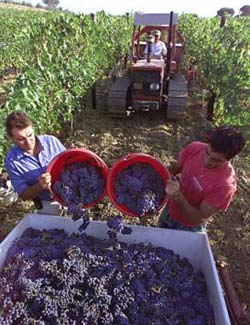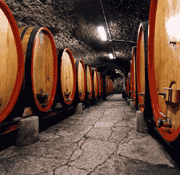Bordeaux & the Cabernet Grape
 One
of the keys to Cabernet's success in
One
of the keys to Cabernet's success in
 Cabernet
Sauvignon is a brash, vigorous vine that grows easily in a variety of different
soils all over the world. It survives cold winters and buds late. However it
does need dry, well-drained soils and lots of sunshine to ripen properly. This
explains why the gravel peninsula of the Médoc and
Cabernet
Sauvignon is a brash, vigorous vine that grows easily in a variety of different
soils all over the world. It survives cold winters and buds late. However it
does need dry, well-drained soils and lots of sunshine to ripen properly. This
explains why the gravel peninsula of the Médoc and
The key to producing good quality Cabernet is to control its growth. It grows
extremely easily, producing lots of leaves and shoots, and therefore needs to be
pruned quite severely and hedged during the summer months. Cabernet produces
small, round berries that are thick skinned and blue tinged. This can be crucial
at the end of the growing season when rain can risk piercing and rotting the
grapes and diluting the juice. Its thick skin also means the variety is not
attacked by insects. In the past, the disadvantage of Cabernet Sauvignon was its
relatively low yields. Yet today, in our search for quality, this characteristic
has become more of a virtue.
 Cabernet's
berries contain a very high ratio of pip to pulp (almost one to 12), which can
make the wine harsh and tannic if it is not tempered by other grape varieties.
In California, Cabernet Sauvignon is chiefly produced as a single varietal wine.
But more recently,Cabernet Sauvignon is increasingly being produced as part of a
"
Cabernet's
berries contain a very high ratio of pip to pulp (almost one to 12), which can
make the wine harsh and tannic if it is not tempered by other grape varieties.
In California, Cabernet Sauvignon is chiefly produced as a single varietal wine.
But more recently,Cabernet Sauvignon is increasingly being produced as part of a
"
A word should be said here about Cabernet Franc. In spite of its name, it bears
little relation to Cabernet Sauvignon. In hot years, Cabernet Franc comes into
its own in
 Cabernet
Sauvignon is usually harvested during the month of October. Most winemakers
juggle between waiting for optimum ripeness in their grapes while gambling with
the vagaries of the autumn climate. When the gamble pays off, this can make the
difference between an average and a great vintage.
Cabernet
Sauvignon is usually harvested during the month of October. Most winemakers
juggle between waiting for optimum ripeness in their grapes while gambling with
the vagaries of the autumn climate. When the gamble pays off, this can make the
difference between an average and a great vintage.
During vinification, Cabernet grapes release a high level of phenolics that
provide a rich palate of aromas in the resulting wine. To encourage these aromas
and to make the wine softer, Cabernet is often fermented quite fast with
frequent pumping over and quite high temperatures. A host of concentration
techniques are increasingly being employed in the top estates of
 An
important quality of Cabernet is its affinity with oak. The tough fruit tannins
of the grape are gradually leached by wood aging, especially if the wine is
stored for a year or so in small new barrels made from tightly grained French
oak. One of the great joys of Cabernet Sauvignon in
An
important quality of Cabernet is its affinity with oak. The tough fruit tannins
of the grape are gradually leached by wood aging, especially if the wine is
stored for a year or so in small new barrels made from tightly grained French
oak. One of the great joys of Cabernet Sauvignon in

Information and tips for finding end enjoying everyday wines from Europe and other major wine regions:
Search the Blogs
Copyright WineNews.com 2009

